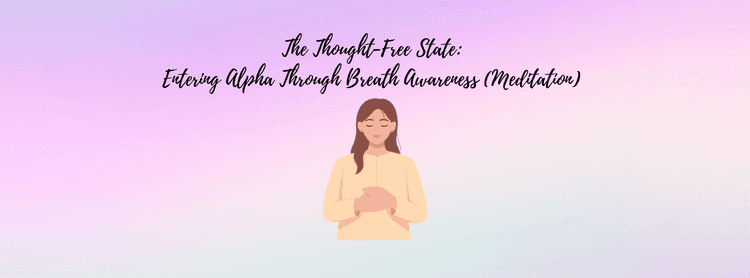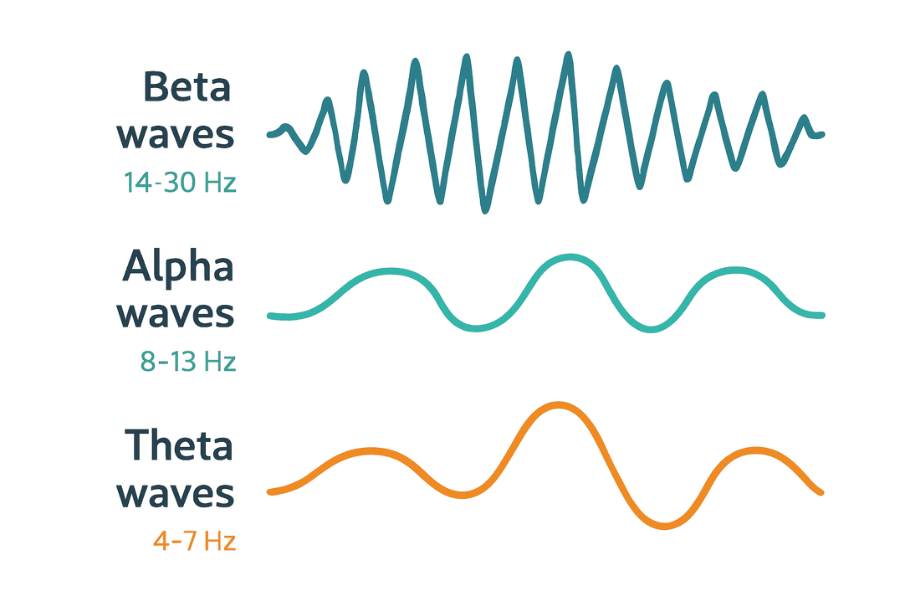The Thought-Free State: Entering Alpha Through Breath Awareness (Meditation)

In the beginning, meditation feels like sitting with a storm. Thoughts swirl, memories rise, and the mind races from one corner of the past to the next bend of the future. But something subtle begins to shift when we simply observe the breath — not control it, not judge it, just witness it.
This witnessing is the doorway to the first grand happening in meditation:
Nirmal Sthiti — the state of thoughtlessness.
From Beta to Alpha: The Brain’s Journey Inward
Modern neuroscience confirms what yogis have known for centuries: meditation changes the brain’s rhythm.
- Beta waves (14–30 Hz): Our normal “thinking” state. Useful for problem-solving, but easily overstimulated by stress and screens.
- Alpha waves (8–13 Hz): A calmer, slower rhythm that appears when we relax and focus inward. Linked to creativity, intuition, and learning.

In meditation, the brain naturally shifts from busy beta waves toward alpha and theta waves. This is the neurological signature of calm alertness.
Our brain operates in different wave patterns. In daily life, we function mostly in beta waves — fast, alert, and often stressed. But as we settle into breath awareness, the brain gently shifts into alpha and theta waves — slower rhythms linked to creativity, intuition, and healing.
What Science Shows Happens in Meditation
When breath awareness begins to deepen, measurable changes ripple through the body and mind:
1. Stress Hormones Decline
Cortisol, the body’s main stress hormone, begins to reduce within minutes of calm breathing.
Lower cortisol means less inflammation, improved immunity, and better sleep cycles.
Over weeks of practice, average cortisol levels drop significantly, buffering you against chronic stress.
2. Heart and Breath Synchronize
Heart rate slows and becomes more variable (higher HRV = greater resilience).
Breathing deepens and steadies, engaging the diaphragm and stimulating the vagus nerve.
This vagal activation directly signals the body to switch into parasympathetic mode—rest, repair, and digest.
3. Nervous System Balance Restored
The sympathetic system (“fight-or-flight”) steps back.
The parasympathetic system (“rest-and-repair”) takes over.
This shift is why meditators often report warmth in the body, digestion improving, or tension easing from the muscles.
4. Brain Regions Realign
Amygdala (fear, reactivity) activity decreases, meaning fewer anxious triggers.
Prefrontal Cortex (focus, decision-making) activity increases, improving attention and self-regulation.
Hippocampus (memory and learning) density increases over time, helping with clarity and emotional balance
Default Mode Network (DMN), the “wandering mind circuit” quiets down, reducing rumination and overthinking.
5. Emotional Stability Grows
Studies show increased production of serotonin (linked with calm mood) and dopamine (linked with motivation and reward).
Meditators display less startle response, steadier reactions to stress, and faster recovery from negative emotions.
Why This Matters
This is more than relaxation. The shift into alpha/theta states creates a neuro-biological environment for healing and growth:
- The body conserves and rebalances energy.
- The mind feels lighter, clearer, less reactive.
- Emotional habits begin to soften.
All of this begins with something simple: sitting with your natural breath.
Scientific studies show that during meditation:
- Cortisol (the stress hormone) begins to drop
- Heart rate stabilizes
- The nervous system enters a repair mode
It’s as if the brain whispers, “I can rest now.”
But this is not sleep. You remain fully alert — yet profoundly still.
Silence That Heals
In this state, silence is not the absence of sound — it is the absence of mental noise. The body relaxes, the breath becomes soft, and the mind no longer pulls you in every direction. This silence is medicinal. It calms the limbic brain, reduces emotional reactivity, and allows the body’s energy systems to realign.
Research shows thought-free states improve immune response, pain tolerance, emotional regulation, and even neuroplasticity.
Many seekers describe this moment as a gentle pause in time — where nothing needs to be done, and everything feels whole.
Thoughtlessness is Not Emptiness
It is important to understand: Nirmal Sthiti is not blankness.
It is presence without distraction.
You are aware, but not entangled.
You are alive, but not reactive.
You are still, but deeply connected.
This is the beginning of true inner transformation.
And it all begins with one breath… then another… then another.